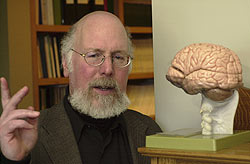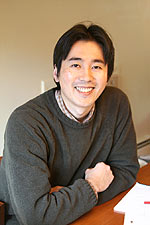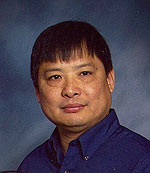REDMOND, Wash. – April 2, 2008 – Imagine a world where computers can predict the effects of brain injury to help with rehabilitation, conduct genetic research on plants to develop new biofuels, control stem cells to help with medical treatment and gain a better understanding of plate tectonics and its implications for future life. These projects are among the ten winners that Microsoft External Research revealed today for its A. Richard Newton Breakthrough Research Award. This award provides a total of $US 1 million in funding to encourage breakthrough academic research to help solve some of today’s most challenging societal problems.
Microsoft created the award program last year in honor of the late A. Richard Newton, former dean and professor of the College of Engineering at the University of California, Berkeley, and a longtime member of Microsoft Research’s Technical Advisory Board. Newton died in January 2007.

Stephen Kosslyn
“With this award, we want to help academic researchers pursue promising new directions at the intersection of computing and other disciplines that have the potential to produce profound results,” said Sailesh Chutani, senior director of the Microsoft External Research. “We named this award in honor of Richard Newton because he was a strong advocate of multidisciplinary research.”
The 10 winning proposals, submitted by researchers at 10 different universities, were selected by a panel of subject-matter experts from more than 89 proposals from universities worldwide. The proposals were evaluated primarily on the basis of potential impact and the academic researchers’ qualifications to perform the proposed research. A number of the winning proposals depend upon the ability of computers today to simulate or model extremely complex phenomena.
“Microsoft’s A. Richard Newton Breakthrough Research Award gives academic researchers like me a chance to do research that is truly on the edge, work that the usual sources of funding would consider too speculative to sponsor,” said Stephen Kosslyn, an award recipient from Harvard University.
Highlights of some of the winning proposals include:

Jun Korenaga
Brain Injury Rehabilitation: Kosslyn, the John Lindsley Professor of Psychology and chair of the Psychology Department at Harvard University, proposes to build a computer model to understand the effects of brain injury. “There are more than 700,000 cases of stroke per year in the U.S.,” according to Kosslyn. “Physicians have gotten pretty good at assessing which part or parts of the brain have been physically damaged as the result of a stroke, but not very good at quickly and precisely diagnosing what the consequences of the damage will be on a person’s thinking, emotions, and behavior. I want to build a computer simulation of the brain that can mimic the effects of damaging either a function or connections among functions, starting with visual cognition. I’m hoping that this model can be used to predict the best rehabilitation regimen for a specific patient.”
Stem Cell Manipulation: Shaofan Li, an associate professor of Computational and Applied Mechanics at the University of California, Berkeley, plans to simulate the chameleon-like ability of stem cells to develop into whatever structure to which they are adhered. “The discovery in 2006 that stem cells can sense their environment and adapt their development to it – a process called mechanotransduction – was a major advance in cell biology,” said Li. “But the exact molecular mechanism for mechanotransduction in stem cells is still unknown, and is under active investigation. I hope to create a computational model that can help us understand the biomechanics and biophysics underlying this phenomenon.” If he is successful, Li’s work could benefit stem-cell-based medical treatments and other treatments for genetic disorders.
Plate Tectonics: Jun Korenaga, associate professor of geology and geophysics at Yale University, hopes to build a comprehensive statistical framework for estimating the physical laws responsible for plate tectonics. “Understanding the physics of plate-tectonic convection in the Earth’s mantle is one of the most puzzling challenges in geosciences,” according to Korenaga. “I hope to approach this long-standing mystery by formulating it as a quantitative mathematical problem, the solution of which has finally become manageable thanks to recent progress in computer technology.” Korenaga hopes to gain a better understanding of why the plates of the Earth’s crust move, and when in the distant future they might stop moving, which would have significant implications for continued life on Earth.

Shaofan Li
The Newton Award is one of several funding and collaboration programs administered by Microsoft’s External Research group. The group collaborates with the world’s foremost researchers in academia, industry and government to move research in new directions. Computer science is a key driver for advancing many fields where computer technology intersects with traditional sciences. Through Microsoft Research’s partnerships in these and other areas the organization hopes to help researchers and scientists address some of the toughest, most urgent societal challenges. Other Microsoft External Research programs target such areas as multi-core computing, human-robot interaction, gaming in education, digital inclusion and healthcare.
About A. Richard Newton
Until his death on January 2, 2007, A. Richard Newton was dean of the College of Engineering at the University of California, Berkeley and an engineering professor there.
Newton was a pioneer in the design of integrated circuits and the architecture of electronic systems. Such achievements earned him respect as a visionary in the technology industry.
His stature also led to more formal recognition. In 2003, he was named winner of the Phil Kaufman Award, the most prestigious recognition bestowed by the Electronics Design Automation Consortium. A year later, Newton, a native of Australia, was named a member of the Washington, D.C.-based National Academy of Engineering.
“Richard’s advice, experience, and participation in Microsoft’s activities over the years was respected and valued,” said Tom Healy, lead program manager of Microsoft External Research & Programs. “For example, he moderated a distinguished plenary panel at the Microsoft Research 2006 annual Faculty Summit and was a longtime member of Microsoft Research’s Technical Advisory Board.”
Newton served as the driving force in the founding in 2001 of the Center for Information Technology Research in the Interest of Society (CITRIS), a partnership between the University of California’s Berkeley, Davis, Merced, and Santa Cruz campuses and Microsoft and other corporate partners. CITRIS is dedicated to applying information and communication technologies to solve some of the most challenging societal problems in areas such as energy, the environment, transportation, health care, homeland defense, and education.
In addition to his successes as an educator and as a researcher, Newton also enjoyed a rewarding business career. He was the co-founder of a number of design technology companies and sat on the boards of directors for still others. He served on the technology councils or advisory boards of a number of companies, in addition to his work with Microsoft Research.




